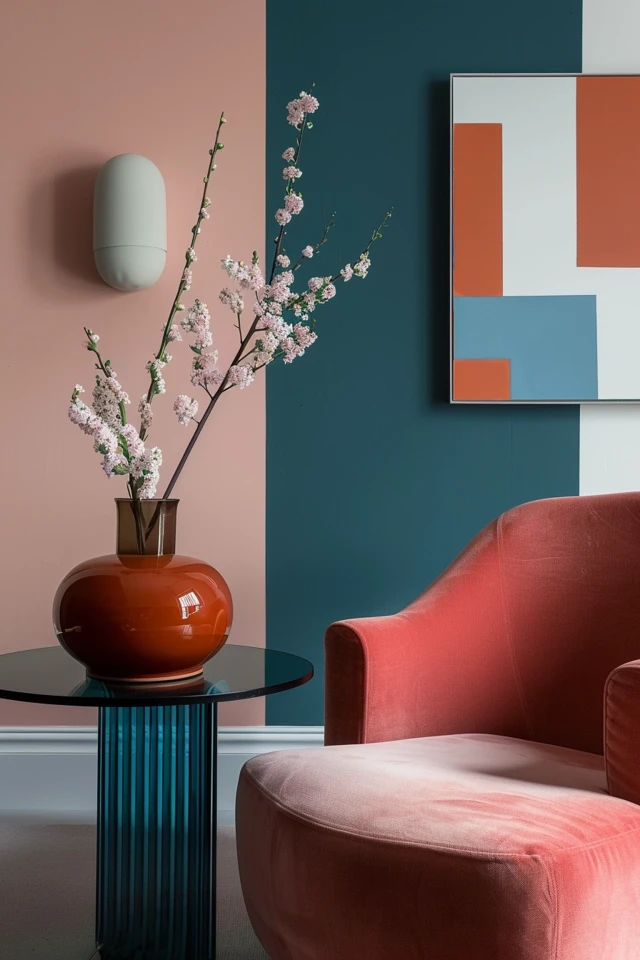Color blocking is a popular trend in both fashion and interior design. It involves pairing contrasting colors to create bold focal points. In interior design, color blocking can be used to transform spaces into vibrant, modern canvases. There are various ways to incorporate color blocking into your home, from painting entire rooms with intense and bold colors to creating more subtle color combinations. By using paint to divide a space or highlight architectural details, color blocking can define and enhance different areas of a room. Additionally, color blocking doesn’t have to be limited to walls – it can be applied to furniture, art, and even doors. By using different shapes and lines, such as rectangles, ovals, and waves, color blocking can add personality and visual interest to any space.

Key Takeaways:
- Color blocking is a popular trend in fashion and interior design.
- It involves pairing contrasting colors to create bold focal points.
- Color blocking can be used to transform spaces into vibrant, modern canvases.
- It can be applied to walls, furniture, art, and even doors.
- By using different shapes and lines, color blocking adds personality and visual interest to any space.
Modern Color Blocking Trends and Tips
In modern color blocking, there are several trends and tips that can help you create a vibrant and visually stunning space. One popular trend is to paint walls halfway, with a bright or contrasting color on the lower half of the wall. This technique creates a striking visual effect without overwhelming the room.
Another trend in modern color blocking is the use of multiple colors within a color-blocked design. This can be achieved by creating geometric shapes with different shades or by layering various colors to add depth and dimension to the walls. By experimenting with different color combinations, you can create a unique and eye-catching look.
To ensure clean and precise lines in color blocking, painters tape can be your best friend. Use it to create sharp edges and borders for your color-blocked designs. Remember to paint over the edge of the tape with the existing wall color first to prevent bleed-through. When painting stripes or multiple sections, it’s advisable to remove the tape while the paint is still wet to achieve crisp lines.

While walls are a common canvas for color blocking, don’t limit yourself to just painting them. You can extend color blocking to furniture, accessories, and even artwork to create a cohesive and visually striking look throughout the space. By incorporating color blocking into other elements of the room, you can achieve a modern and cohesive design.
“Color blocking allows you to play with different hues, shapes, and patterns to transform any space into a true work of art.”
Remember, color blocking is all about creativity and personal expression. Don’t be afraid to think beyond the walls and experiment with different patterns, shapes, and textures. Whether you choose bold and contrasting colors or more subtle and harmonious combinations, color blocking can bring a modern and dynamic energy to your space.
Color Blocking Patterns
If you’re looking for inspiration, here are some popular color blocking patterns to consider:
- Vertical or horizontal stripes
- Diagonal lines or angles
- Geometric shapes such as rectangles, triangles, or circles
- Ombre gradients
- Checkerboard or chessboard patterns
- Abstract or free-form designs
These patterns can be used on walls, furniture, or even in the choice of accessories and decor. Get creative and have fun exploring different color blocking patterns to bring your space to life.

Color Blocking Room Ideas for Every Space
Color blocking is a versatile technique that can be applied to various rooms and spaces in your home, allowing you to create unique and vibrant environments. In living rooms or bedrooms, consider using color blocking to define different areas or to create a focal point around a piece of furniture. By painting a rectangular shape on the wall or using contrasting colors to highlight architectural features, you can add visual interest and depth to the space.
In kids’ rooms, color blocking can be a playful and exciting way to stimulate their imagination. Painted stripes or geometric shapes on walls or furniture can add energy and character to the space while creating a fun and dynamic atmosphere. Additionally, color blocking can be applied to smaller areas, such as doors or ceilings, to create unexpected pops of color and create a sense of surprise.
In spaces like entryways or hallways, color blocking can make a bold statement and create visual interest as soon as you step inside. By experimenting with different colors and shapes, you can personalize your color blocking design to reflect your unique style and preferences. Remember, color blocking offers endless possibilities for transforming spaces with paint, allowing you to unleash your creativity and make your home truly one-of-a-kind.

